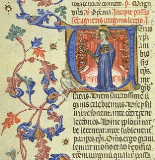Sainte Agnès
Vous trouverez ci-après le récit de la vie de Sainte Agnès, en français, puis en anglais (je vous invite à lire les deux versions car elles sont un peu différentes).
Go down if you want to know more about the life of Saint Agnes (in English !).
Fille romaine, agée de douze à treize ans, martyrisée et inhumée au bord de la Via Nomentana, où l'on construisit à l'époque de Constantin le Grand une basilique en son honneur. Saint Ambroise, saint Damase et Prudence, firent son éloge. Son nom se trouve dans la première prière eucharistique et, en tant que patronne des vierges, elle est une des saintes les plus populaires. L'art la représente avec un agneau et parfois avec une colombe portant une bague dans le bec.

Sainte Agnès.
Bréviaire de Martin d'Aragon
Espagne, Catalogne, fin du XIVe s.
Sainte Agnès vierge et martyre
La fête de ce jour nous rappelle un des plus touchants et des plus beaux triomphes de la foi chrétienne; elle nous montre une faible enfant de treize ans sacrifiant, pour l'amour de Jésus-Christ, tout ce que le monde a de séduisant, noblesse, fortune, jeunesse, beauté, plaisirs, honneurs. L'admiration pour cet héroïsme ne suffit pas; le martyre de sainte Agnès renferme de grandes leçons qu'il faut mettre en pratique.
Agnès, enfant de l'une des plus nobles familles de Rome, se consacra au Seigneur dès l'âge de dix ans. Elle avait à peine treize ans, quand un jeune homme païen, fils du préfet de Rome, la demanda en mariage; mais Agnès lui fit cette belle réponse: Depuis longtemps je suis fiancée à un époux céleste et invisible; mon coeur est tout à lui, je lui serai fidèle jusqu'à la mort. En l'aimant je suis chaste; en l'approchant je suis pure; en le possédant je suis vierge. Celui à qui je suis fiancée, c'est le Christ que servent les anges, le Christ dont la beauté fait pâlir l'éclat des astres. C'est à lui, à lui seul, que je garde ma foi, c'est à lui que je me dévoue entièrement.
Peu après, la noble enfant est traduite comme chrétienne devant le préfet de Rome, dont elle avait rebuté le fils; elle persévère dans son refus, disant: Je n'aurai jamais d'autre époux que Jésus-Christ. Le tyran veut la contraindre à offrir de l'encens aux idoles, mais sa main ne se lève que pour faire le signe de la croix. Supplice affreux pour elle : on la renferme dans une maison de débauche. Je ne crains rien, dit-elle, mon Epoux, Jésus-Christ saura garder mon corps et mon âme. Et voici, ô miracle, que ses cheveux, croissant soudain, servent de vêtement à son corps virginal, une lumière éclatante l'environne et un ange est à ses côtés. Le seul fils du préfet ose s'approcher d'elle, mais il tombe foudroyé à ses pieds. Agnès lui rend la vie, et, nouveau prodige, le jeune homme, changé par la grâce, reconnaît le Dieu du ciel et se déclare chrétien. Agnès est jetée sur un bûcher ardent, mais les flammes la respectent et forment comme une tente autour d'elle et au-dessus de sa tête. Pour en finir, le juge la condamne à avoir la tête tranchée. Le bourreau tremble, il faut qu'Agnès l'encourage : Frappez, dit-elle, frappez sans crainte pour me rendre plus tôt à Celui que j'aime; détruisez ce corps qui, malgré moi, a plu à des yeux mortels. Le bourreau frappe enfin, et l'âme d'Agnès s'envole au ciel le 21 janvier 304. Les actes de son martyre mettent dans sa bouche ces belles paroles : Je suis toute à mon Epoux céleste; je l'aime plus que ma vie, et je suis prête à mourir pour lui.
Pratique : Ayez un soin jaloux de conserver purs votre âme et votre corps.
Prière à Sainte Agnès
Ô sainte Agnès,
vous êtes l'espoir et le soutien
de ceux qui font appel à vous,
tournez vos yeux bénins vers nos misères
et déployez les ailes de votre protection sur nous.
Ô sainte Agnès
épouse immaculée de Christ,
implorez la sainteté de notre âme et notre corps,
du ciel où vous êtes
avec votre consoeur sainte Catherine de Sienne.
Pater, Ave e Gloria.
Young Saint Agnes is one of the most famous of the early Roman martyrs. Her name means 'lamb' or 'victim' in Latin and 'pure' in Greek. Remember that Jesus is sometimes called the 'lamb of God.'
Agnes lived in Rome at a time when it was against the law to be Christian. She was young, wealthy and beautiful. There were many young men in Rome who wanted to marry her, but she refused them all, saying that she had chosen Someone else. The suitors (young men who wanted to marry her) accused her of being a Christian.
Her accusers and the judge tried to frighten her into abandoning her faith by showing her instruments of torture, and fires, but she won't change her mind. Then they sent her to a prison where there were many rough people, but she still wasn't frightened. One young man tried to hurt her, but he was struck blind and fell down shaking. Agnes remained loyal to Christ throughout all these trials.
Finally, the judge ordered that she be executed. Everyone thought that this last threat would make her change her mind and worship another god. But Agnes went to the place of execution cheerfully, because she knew that she would meet her beloved Jesus soon. She was beheaded, and her body was buried close to Rome on the Nomentan Road (Via Nomentana).
A big church, called a basilica, was built in her honour over the place where she was buried about 50 years after she died. For centuries, two lambs have been brought to the church and blessed every year. The lambs are then reared in a cloister. When they have grown into sheep, their wool is used to make 'palliums' which are special stoles. The Pope sends these stoles to archbishops to wear on their shoulders as symbols of the sheep carried by the Good Shepherd.
Saint Agnes is one of the best known and honoured of the Roman martyrs. She suffered martyrdom during the persecution of the Emperor Diocletian in 304 or 305. She was only twelve years old. Her name which means 'lamb' or 'victim' in Latin, and 'pure' in Greek, is still invoked in the First Eucharistic Prayer for Holy Mass.
The stories of her martyrdom date from the 5th century, about one hundred years after her death, so there are not many details known about her life. It is certain though that young noblemen of Rome, attracted by her youth, wealth and beauty, courted her, asking her hand in marriage. She declined all their offers, saying that she had chosen a Spouse who could not be seen with mortal eyes. Hoping to change the young saint's mind, the suitors accused her of being a Christian.
Saint Agnes was brought before a judge, who at first treated her gently and kindly, because of her young age. In spite of his kindness, she refused to offer incense to the goddess Minerva. Then the judge tried to frighten her with threats of torment. She was shown terrible fires, and tools of torture but remained calm and steadfast in her loyalty to Christ.
Finally, angered by her stubbornness, the judge ordered that she be sent to a house of prostitution, a rough and immoral place. Here, the sight of the saint struck respect and awe into most, but one youth, bolder than the rest, attempted to molest her. He was 'struck down, as if by lightning' and fell to the ground, blind. Throughout this ordeal Agnes remained chaste and pure, still a spotless spouse of Christ.
The most influential of her suitors was angered by this event, and convinced the judge to order Agnes executed. Spectators wept to see the young and beautiful virgin, hampered by fetters, joyfully making her way to the place of execution. The executioner had secret orders to make one last attempt to persuade her to deny Christ and live. Again, Agnes refused.
Finally, with a trembling hand, the executioner beheaded this most famous of martyrs. Agnes went to meet Jesus, who she loved more than life. She was buried on the Via Nomentana, just outside of Rome, and the Christian emperor Constantine erected a church in her honour about the year 350.
For centuries, an annual celebration blesses two lambs at the altar in this church where her relics lie. The lambs are then sent to a cloister and raised. Their wool is used to make the palliums sent by the Pope to archbishops. The palliums are worn around the archbishop's shoulders as symbols of the sheep carried by the Good Shepherd.

Saint Austin observes that Saint Agnes' name means chaste or pure in Greek and lamb or victim in Latin. She has always been regarded by the Church as a special patroness of purity.
Agnes was martyred early in the persecution of Diocletian, who began his persecution of Christians in March of 303. She was only twelve or thirteen years old at the time of her death (accounts differ) Even at that young age, her wealth and beauty had attracted the attention of the young noblemen of Rome, who competed with each other for her hand in marriage. She spurned them all, saying that she had consecrated her virginity and chosen a Spouse who could not be seen with mortal eyes.
Her suitors accused her to the governor as a Christian. At first, the judge was mild, gentle and kind to the young saint, promising her money and position if she would offer incense to another god. Agnes refused. He then threatened her with terrible fires, iron hooks, racks and other instruments of torture, but the young girl was filled with courage and remained steadfast, unafraid of what might befall her.
Seeing that his threats were ineffective, the judge then threatened to send Agnes to a house of prostitution. Agnes replied that Jesus Christ was too jealous and protective a spouse to allow her purity to be violated. Angered, the judge ordered that she be taken immediately to the public brothel with instructions that all persons were at liberty to abuse her person.
Many people came to see and join in the spectacle. But at the sight of the young saint, still calm and trusting in Christ to protect her, they were frightened and dared not approach. Only one young man, bolder than the rest, attempted to molest her. At that instant, in a flash, he was struck blind and fell to the ground trembling. His friend picked him up and brought him to Saint Agnes whose prayers restored him to sight and health.
The governor, finally realising that little or nothing would sway her conviction, condemned her to be beheaded. The executioner had secret instructions to induce her to change her mind when faced with death, but Agnes answered that she would never betray Jesus Christ in that way, by serving another god. Making a short prayer, she knelt and allowed the executioner to carry out his work.
She went to the arms of her Heavenly Spouse, whom with her faithfulness and courage proved that she loved more than life itself.
PRAYER
All-powerful and ever-living God,
You chose the weak in this world to confound the powerful.
As we celebrate the anniversary of the martyrdom of Saint Agnes,
may we like her remain constant in faith. Amen.